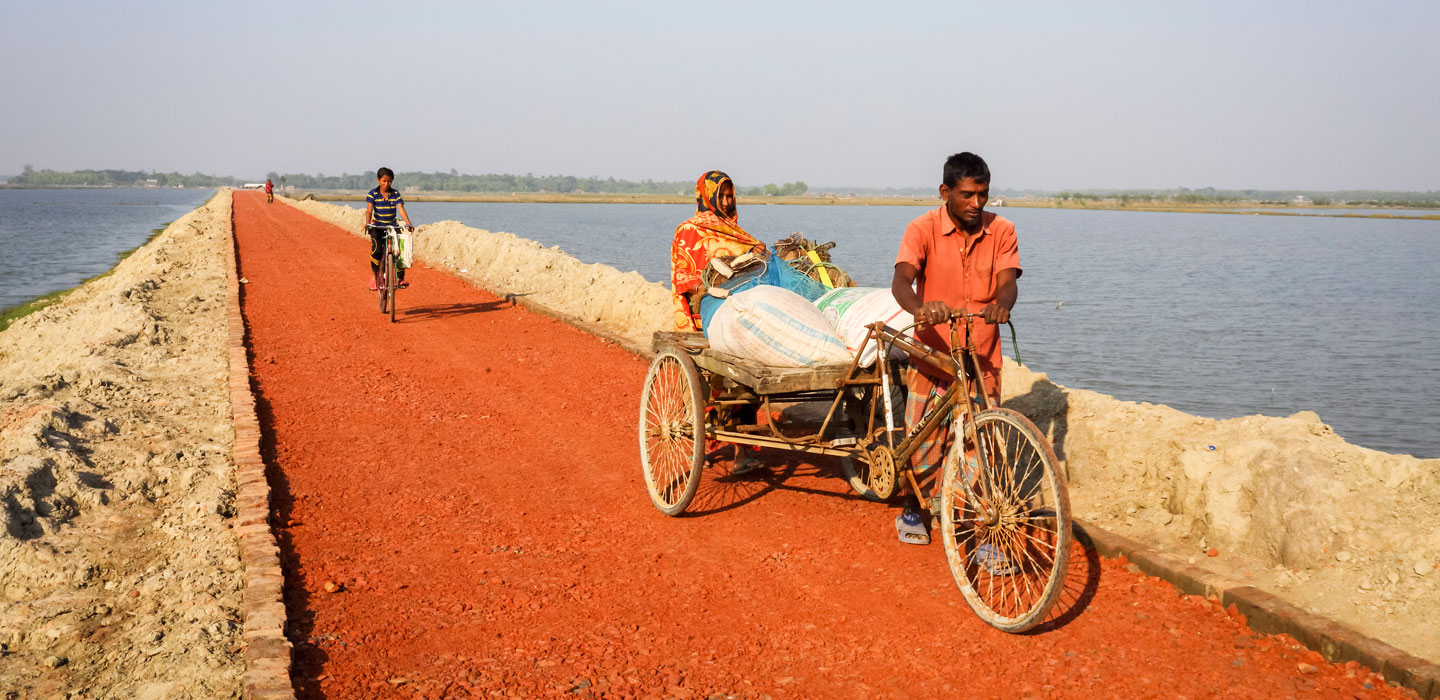There is a growing climate emergency facing smallholders across Asia Pacific – what is IFAD doing about it?
IFAD Asset Request Portlet
Asset Publisher
There is a growing climate emergency facing smallholders across Asia Pacific – what is IFAD doing about it?
By Nigel Brett

According to UN reports, the Asia Pacific region is the most disaster-prone region in the world. Nearly 45 per cent of the world’s natural disasters occur in the region. With regularly occurring typhoons, cyclones, droughts, floods, and landslides, local populations are often ill prepared to cope with the devastating impacts from such extreme weather events. Importantly, climate change is magnifying both the scale and frequency of these events. To compound matters, with low lying coastlines and deltas (including the Mekong, the Indus, the Ganges-Brahmaputra) that are home to hundreds of millions of people, and with many small islands developing states (SIDS), the regional geography makes rural communities even more vulnerable to climate induced sea level rises and flooding. As the Climate Adaptation Summit 2021 rapidly approaches, it is the right moment to revisit the climate crisis facing smallholder producers across Asia Pacific, and to take stock of what needs to be done over the coming decade to ensure that the most vulnerable populations have access to the support that they need.
The good news is that IFAD is making bold institutional reforms to address the issues, including an increased corporate target for climate financing (from 25 per cent to 40 per cent of IFAD funding going towards climate related activities over the next three years), and with a new Rural Resilience Programme (2RP) targeting vulnerable smallholders in low-income countries (LICs) and SIDS with funding for adaptation. IFAD is also working much more closely with development partners, such as the Global Environment Facility (GEF) and Green Climate Fund (GCF) to ensure the coordination and diversification of resources and effort. So what kind of interventions will IFAD be prioritizing over the coming decade in Asia and the Pacific?
Managing fresh water efficiently
Farmers in many countries are facing increased risks from fresh water shortages. Some things that can be done to mitigate risks are: maintain fully-functioning watersheds - which in turn maintain healthy floodplains to enable groundwater recharge; upgrading the lining of irrigation canals; adopting crop management practices that require less water (such as alternate wetting and drying rice crops, or installing drip-irrigation systems); switching to less water hungry or more drought tolerant crops; ensuring fair and equitable water allocation; and installing rainwater harvesting systems in fields or on rooftops.
IFAD projects are providing good working examples of how to achieve more water efficiency, especially in South Asia which has the lowest water security in the region, and the Pacific where most islands have limited fresh water resources. In Sri Lanka, IFAD’s Smallholder Agribusiness Partnerships Programme (SAPP) is building farmers’ capacity to apply soil moisture conservation methods and water saving technologies such as mulching and drip/sprinkler irrigation, while at the same time promoting drought tolerant crops such as moringa, cowpea, and chili.
In Bangladesh, the IFAD/ADB Participatory Small-scale Water Resources Sector Project (PSSWRSP) has focused on improving irrigation efficiency across hundreds of small irrigation schemes covering 220,000 ha, and benefitting 280,000 farming households. Community-level water management associations set up under the project to manage each individual scheme, have been empowered to better understand risks of climate shocks, and therefore have been able to save crops from both droughts and floods by controlling water flows. In Myanmar, the Eastern States Agribusiness Project is helping to improve the lining of canals to reduce water losses. And, in Kiribati, IFAD’s Outer Islands Project has been introducing rainwater harvesting systems to mitigate fresh water shortages during the long dry seasons.
Reducing land degradation
Land degradation across the region is increasingly compromising the ability of smallholder farmers to sustain their livelihoods. Climate change is exacerbating and amplifying the damage caused by overly intensive use of the land and inappropriate management of fragile or sloping land. In some cases, the lack of clear incentives for sustainable management – for example in the case of open access resources – is adding to the challenge. However, options are available to reverse these trends while at the same time building sustainable livelihoods. Some approaches that work are: supporting technical advances for production on sloping land, such as Sloping Agricultural Land Technology (SALT) and agro-forestry techniques; providing smallholders with long term tenure security to build incentives for land care; and investing in soil and water conservation approaches such as minimum tillage, terracing, contour farming, and check-dams.
IFAD’s Leasehold Forestry Project in Nepal provided long-term leases for management of degraded forestland to landless women. This has led to quick natural regeneration of forest cover, reductions in soil erosion, and big increases in income for women from their new forest enterprises. In India, the Fostering Climate Resilient Upland Farming Systems in the North East Project (FOCUS) is supporting more sustainable approaches to shifting cultivation and promoting drought resilient local crops such as arhar or yellow lentil. In Bangladesh, IFAD has promoted technologies to reduce the damage to soil and water from intensive cultivation, for example deep placement of urea super granules, using pheromone traps to reduce pesticide application, and leaf colour charts to reduce fertilizer application. In Nepal, the ASAP-funded Adaptation for Smallholders in Hilly Areas Project (ASHA) project is supporting villages to be climate-smart and to prepare local adaptation plans, introducing positive changes across entire watersheds, which include mixed cropping, appropriate crop rotation, use of bio-pesticides and bio- fertilizers, and bio-char incorporation into the soil.
Southeast Asia has the highest global deforestation rate and in recent decades, an intensification of peatland degradation resulting in massive GHG emissions and the regional haze crisis. IFAD has developed a sub-regional programme for sustainable peatland management to address the issues. The Sustainable Management of Peatland Ecosystem in Indonesia (SMPEI) project supports national-level mapping of peatland hydrological units, alternative fire-free livelihoods and practices, as well as the development of the national monitoring systems for peatland fire prevention and control - which serves as both an early warning system and a way of assessing the success of peatland restoration efforts.
Protecting coastlines, reefs and mangroves
Coastlines across Asia are currently facing multiple threats. Overfishing and poor coastal management practices are depleting fish stocks while also degrading important coastal habitat. Removal of mangroves for firewood or cultivation is enhancing the risk of flooding. On top of everything, global warming is causing sea levels to rise and an increase in extreme weather incidents on coastlines. The impacts are well publicized and alarming, and the communities that live on coastlines are often the poorest and most vulnerable. However, options to reverse or adapt to these trends do exist, and some innovative on-going projects are providing inspiration for future investments.
 |
| ©IFAD/Roger Arnold |
In over 180 villages in Indonesia, the IFAD-supported Coastal Community Development Project (CCDP) has introduced aquaculture and supported initiatives to make fishing and processing techniques more efficient and sustainable. The project worked with local fishing communities to establish marine protected areas, and to introduce integrated coastal management plans. The Char Development and Settlement Project (CDSP) in Bangladesh has built multi-purpose cyclone shelters on vulnerable areas of coastline. These shelters serve as schools, but double up as cyclone shelters when needed. The project has also supported construction of climate-proofed roads that remain intact even after they have been repeatedly submerged in water. It has also helped communities to develop small businesses (such as duck raising) that can withstand floods. Finally, in Tonga, the TRIP project is planting tree species that can protect the coastline from tornados and cyclones.
Across Asia and Pacific, trends in environmental degradation, and the accompanying impacts on poverty and food security of rural populations, are raising serious concerns for policymakers. Yet many of the solutions needed to reverse these trends already exist. What is absolutely clear from experience so far is that the local populations of smallholder producers themselves can be champions in delivering positive environmental outcomes. What is needed is political will, and prioritizing and directing development finance to these most vulnerable rural populations, to support and elevate them to become powerful actors in the sustainable management of healthy ecosystems and plentiful food production.
Publication date: 20 January 2021